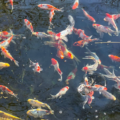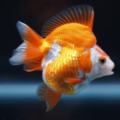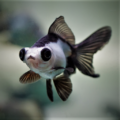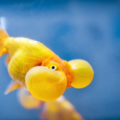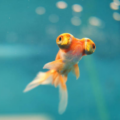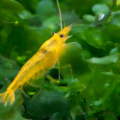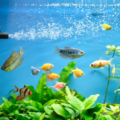Learn about the distinctive characteristics of the Lionhead Goldfish to better protect and nurture this aquatic beauty with the right tank setup and health tips.

Lionhead Goldfish: Distinctive Features and Characteristics
The Lionhead Goldfish has been an all-time favorite amongst hobbyists and has quickly gained popularity because of its unique features. Also called the fat-head goldfish it belongs to a family of rare goldfish varieties like the Ranchu and Oranda goldfish.
The visually stunning Lionhead appearance is owed to its short and egg-shaped body with a double caudal fin. This unique goldfish is available in different colors, including rare varieties like the red-capped and long-finned Lionhead.
A distinctive feature of this goldfish is its Lionhead hood, called a wen. The appearance of this head growth varies, with some completely covering their head and hindering their vision, while some may have no wen at all.
If you want to get better at goldfish identification, you are in the right place. This guide provides all the information you may need on the Lionhead goldfish; you’ll learn why it’s considered unique among other goldfish types.
History and Origins
The Lionhead goldfish history dates back to the 17th and 18th century China, where it was bred and developed. This Chinese goldfish is a vibrant species uniquely known for its striking features.
The origin of Lionhead goldfish can be traced to a species of wild carp that inhabited slow-moving water bodies. The goldfish’s iconic head shape is similar to that of a lion’s mane, which signifies power, courage, and guardianship in Chinese culture. The Lionhead’s cultural significance shows that it symbolizes wealth, prosperity, and good luck.
Physical Appearance

Starting with the body shape, Lionhead goldfish has an egg-shaped silhouette with a big belly. The Lionhead goldfish’s appearance makes it look quite similar to an Oranda goldfish, but without a dorsal fin.
This goldfish makes up for the absence of a dorsal fin with its double anal and caudal fins. Besides its shape, it comes in various goldfish colorations, ranging from black to blue, tricolored, red, orange, and chocolate.
The most distinctive characteristic is the Lionhead wen growth, which develops as they grow. Its wen is a fleshy, raspberry-like growth that covers its entire head, giving it the appearance of a lion.
The wen may not be the best characteristic when comparing goldfish varieties as some species have small or barely any head growth. Meanwhile, others have massive wens that grow over their eyes and affect their visibility.
Lionhead Goldfish Care
Caring for a Lionhead goldfish may be challenging; these goldfish have specific needs and may not be the best pets for beginner aquarists. If you are up to the challenge, you need all the Lionhead goldfish care tips you can get!
They require a specific goldfish tanks setup and regular checks to keep them healthy. The water parameters for goldfish must be correctly set at a stable temperature of 65-72°F and a pH of 6.0-8.0. This is crucial to their health and growth.
Author’s Note: For some planted tank decor tips check out our article on The 8 Best Live Plants for Goldfish Aquariums, there are indeed live plants that can thrive in a goldfish habitat!
Lionhead diet is a mixed variety because they are omnivores but slightly herbivorous. They thrive on live, dried, or frozen foods, but it’s important to maintain high-quality nutrition daily.
The environment of this underwater pet is also important; their tank must include a powerful filter to decrease the large amounts of waste they produce.
Without maintaining proper water parameters, the tank’s water quality can degrade, which can cause a wide range of issues from cloudy aquarium water to illness and mass fish die off.
Tank Mates and Compatibility

Lionhead goldfish are peaceful fish with calm personalities and often pair well with non-aggressive tank mates. Some recommended Lionhead goldfish tank mates are the black moor, bubble eye goldfish, and fantail. There are also a few non-fish compatible species like freshwater crabs and shrimps.
Ensure the shrimps are not small species or have plenty of hiding spaces because this goldfish tends to eat anything small enough to fit in its mouth. Lionhead goldfish compatibility with freshwater snails is greatly beneficial as the snails consume the extra waste and keep the tank clean.
Lionhead are slow swimmers; it is best to avoid placing them with fast-moving fish as they won’t be able to compete for food and may get bullied. An important fish to avoid is the Comet goldfish because they’re known for their speed and tend to grow quite large. Also avoid species of fish known to be fin nippers, like tiger barbs, as they would decimate the fins of the slow moving lionhead.
Common Health Issues

The Lionhead species have delicate head growths and sensitive bodies, making them susceptible to diseases. Some of these Lionhead goldfish health issues may stem from an unclean environment if their tank isn’t kept clean. Be sure to frequently test their water parameters using a master test kit like the one linked below from Amazon.
This unique species can develop infections like fin rot and dropsy; other common goldfish diseases include cotton wool fungus, a fungal infection, and swim bladder disease.
Checking up on your goldfish regularly is a good way of preventing goldfish illnesses. If you notice abnormal swimming patterns or problems with balance, it’s best to begin goldfish treatment immediately.
Breeding Lionhead Goldfish

Lionhead goldfish breeding is relatively straightforward but requires adequate preparation. Start by setting up a breeding tank; it should be large enough to house at least six goldfish.
Separating males and females a few weeks before breeding season promotes goldfish spawning, encouraging them to form breeding pairs when placing them in a tank.
The female can lay up to 10,000 eggs; the eggs should be removed immediately from the tank so they’re not eaten. Proper fry care is also crucial as they need to be fed with fry food until they are big enough to consume flake food. When adequate preparation is made, breeding challenges can be avoided.
Feeding and Nutrition

Lionhead goldfish have a voracious appetite and eat anything that fits into their mouth. They’re healthy eaters that would consume both animal and plant matter, making them both omnivores and carnivores.
Lionhead goldfish feeding can be pretty peculiar because they eat a lot and tend to get overfed. Overeating is a big problem among this species; it is best to feed them a high-quality goldfish diet twice a day.
Some recommended types of goldfish food include Daphnia, bloodworms, brine shrimp, plant matter, vegetables, and fish flakes. It is vital to opt for high-quality fish food with excellent nutritional balance. Also, pay close attention to their feeding frequency to avoid overfeeding them.
We recommend these gold fish pellets:
For more on feeding your aquatic pets check out The Ultimate Guide to Fish Food: Pros and Cons & Best Choices!
Lifespan and Growth
The average Lionhead goldfish lifespan is about 15 years, up to 20 years on rare occasions. However, their lifespan cannot be guaranteed due to factors affecting goldfish longevity, like genetics and disease exposure.
Other factors like feeding habits and environment can further influence goldfish growth. Maintaining a healthy environment with optimum water parameters plays a significant role in maximizing goldfish lifespan and providing your pet with a healthy life.
Conclusion
Caring for a unique goldfish variety can sometimes be challenging, but the results can be so gratifying. Keeping Lionhead goldfish healthy largely depends on your dedication and knowledge of their care requirements. The amount of work it requires makes it best suited for well-seasoned goldfish enthusiasts.




